30
2024
-
12
Laser-based tiered neurons achieve high-speed reservoir computing.
Author:
Neuromorphic computing is a computational paradigm that simulates the functions and architecture of biological neurons. A single biological neuron is a powerful computational unit with information processing capabilities, information transmission capabilities, and memory functions. Therefore, it is crucial to design a photonic neuromorphic processor that can truly simulate the powerful computational functions of biological neurons.
In biological organisms, there are two different types of neurons: spiking neurons and graded neurons. Spiking neurons transmit information through temporally and spatially discrete spikes, making signal processing more efficient and energy-saving. However, spiking neurons have a refractory period, meaning that after responding to a certain input stimulus, they will not respond again for a certain period of time, even if further stimulation is provided (Figure 1a, left). The existence of the refractory period limits the information processing speed of spiking neurons, and neurobiological studies have shown that when signals are converted into a binary spike sequence of 'on or off', information can easily be lost. Currently, the vast majority of photonic laser neurons simulate this type of spiking neuron.
Another type of biological neuron is called a graded neuron. Unlike spiking neurons, graded neurons do not have a refractory period and exhibit graded responses to continuous input stimulus signals (Figure 1a, right). Due to the absence of a refractory period, the response rate of graded neurons is significantly increased, thereby greatly accelerating the speed of information processing and transmission. Additionally, because of their continuous rather than binary coding method, graded neurons can effectively retain and transmit information, achieving high reliability and high precision in signal processing. Therefore, applying photonic graded neurons to artificial intelligence will open up new opportunities for high-speed neuromorphic computing. However, there is currently a lack of practical implementations of high-speed photonic laser graded neurons.
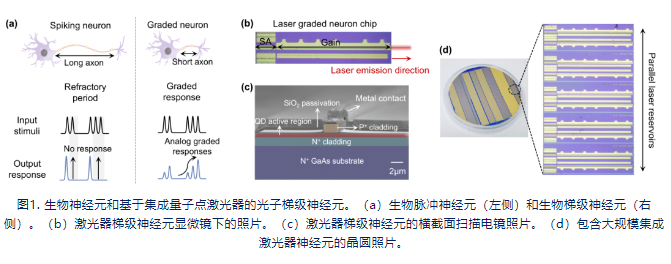
This paper proposes a photonic graded neuron based on integrated quantum dot lasers (Figure 1b-d) and demonstrates its application in high-speed reservoir computing. By applying radio frequency signals to the saturable absorber region of the laser through electrical injection, we successfully avoided the pulse response rate limitation caused by the refractory period. Our laser graded neurons achieved a signal processing speed of 10 Gbaud, which is 9 orders of magnitude faster than biological neurons and 6 orders of magnitude faster than electronic artificial neurons. Many reservoir computing systems based on physical reservoir layer nodes rely on feedback loops or multiple physical nodes to complete machine learning tasks, making these systems more complex and slower. However, due to the strong memory effect and excellent information processing capabilities, our single laser graded neuron can behave like a small neural network. Therefore, even without additional complex connections and feedback loops, a single laser graded neuron can perform machine learning tasks with high performance.
Research Highlights
1. Experimental verification of graded neuron-like characteristics in quantum dot lasers
In common laser spiking neurons, input stimulus signals are injected into the gain part of the laser. In this case, the gain of the laser is modulated by the signal. Since the recovery time of the gain region is much slower than that of the saturable absorber region, the refractory period phenomenon is observed. To avoid the speed limitation caused by the refractory period, we artificially injected radio frequency signals into the saturable absorber region (Figure 2a) instead of the gain region. This method allowed us to observe the graded enhanced response of the laser and avoid the rate limitation caused by the refractory period.
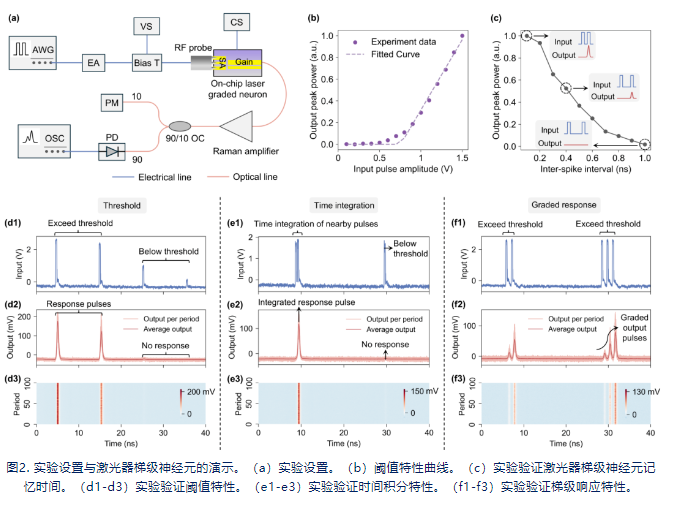
We experimentally verified the following graded neuron-like properties in quantum dot lasers: (1) Threshold excitation characteristics (Figure 2d1-d3): The laser only generates a response pulse when the input stimulus signal exceeds a threshold; otherwise, the laser remains in a resting state; (2) Temporal integration characteristics (Figure 2e1-e3): The laser can accumulate the energy of adjacent input pulses within a specific time window and generate an output pulse response, even if each individual pulse in the input pulse sequence is below the threshold, the laser can trigger an output pulse response through temporal integration characteristics; (3) Graded response characteristics (Figure 2f1-f3): When the laser has been excited in the initial stage and continues to receive input stimulus signals, the laser will produce a progressively enhanced graded response. Additionally, we experimentally verified that the memory duration of the laser graded neuron is approximately 1 ns (Figure 2c).
Reservoir computing is a powerful and efficient computational framework that is well-suited for processing temporal signals. A reservoir computing system consists of an input layer, a reservoir layer, and a readout layer (Figure 3a). In the reservoir layer, a crucial component is the nonlinear nodes, which are connected randomly and fixed, thus avoiding the need for training the reservoir layer. Only the readout layer needs to be trained and can be achieved through simple and efficient methods (such as linear regression). Due to the rich nonlinear dynamic characteristics and high-speed signal processing capabilities, our laser graded neurons are very suitable for application in high-speed reservoir computing.
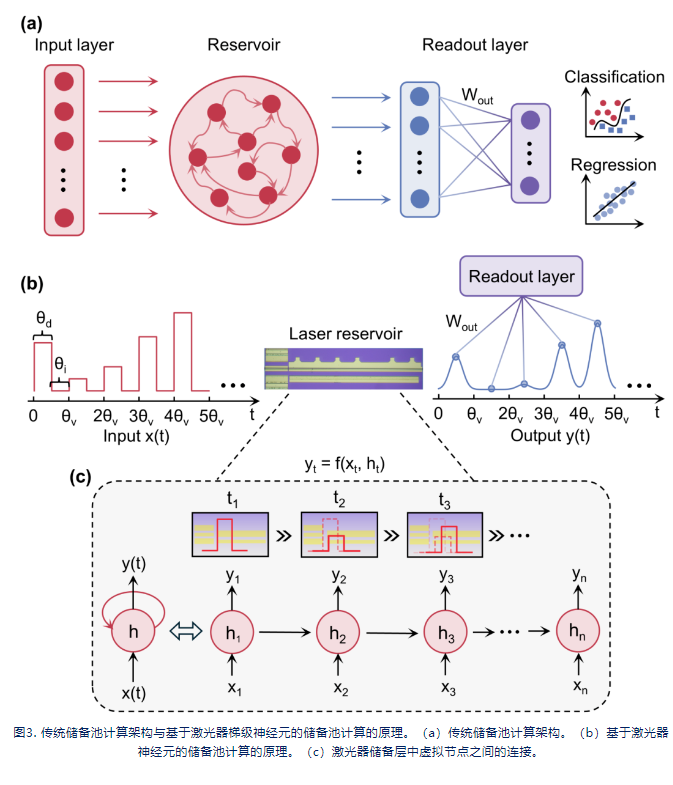
In many physical reservoir systems, time-delayed feedback loops are often relied upon to increase the number of virtual nodes in the system, thereby constructing connections between nonlinear nodes to enhance system performance. However, this not only increases the complexity of the system but also limits the operating speed of the system. Thanks to the memory effect and nonlinear dynamic characteristics of laser graded neurons, we constructed a streamlined reservoir computing system without feedback loops (Figure 3b-c). In the input layer, input signals are encoded as electrical pulse injections into the laser graded neurons. In the reservoir layer, when the duration of each virtual node is less than the memory duration of the laser, the laser reservoir layer can store previous input signals as hidden states, which, along with new input data, jointly determine the output of the laser reservoir layer. The influence of previous virtual nodes is retained in the system and gradually decays over time. Through temporal multiplexing, interconnections between virtual nodes are established. In the readout layer, we sample one point from each virtual node as output. Due to the graded response characteristics, the laser reservoir layer can generate continuous-time outputs. Compared to the binary outputs of spiking neurons, this continuous-time output carries more information and exhibits richer computational expressiveness, making it more effective in training the optimal readout layer.
We validated the pattern recognition capability of the reservoir system based on laser graded neurons with two machine learning tasks. The first task is MIT-BIH arrhythmia detection (Figure 4a-c). In this task, each heartbeat consists of 50 data points, and each data point is encoded as a 100 ps electrical pulse input into the laser graded neurons, resulting in an arrhythmia detection accuracy of 98.4%. The second task is MNIST handwritten digit image classification (Figure 4d-f). In this task, each handwritten digit image is a black and white image of size 12.A 12 black and white image, with the pixel points flattened and sequentially input into the laser graded neurons, ultimately achieving an MNIST image classification accuracy of 92.3%.
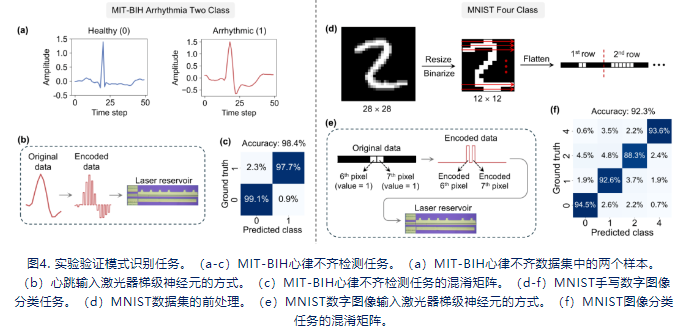
We also used the Mackey-Glass task to validate the sequence prediction capability of the reservoir computing system based on laser cascade neurons. In this task, our goal is to predict the future step i using the latest 50 steps (Figure 5b). By using a multivariable input method (Figure 5a), we expanded the original Mackey-Glass sequence into multiple sequences of different amplitudes, which were sequentially input into the laser cascade neurons. Through the multivariable input method, we can increase the number of virtual nodes in the reservoir computing system to achieve better prediction results. When predicting the first future step, our system achieved a normalized root mean square error (NRMSE) of 0.081 (Figure 5e-f); when predicting the 30th future step, our system still maintained a low error, with an NRMSE of 0.108 (Figure 5g-h).
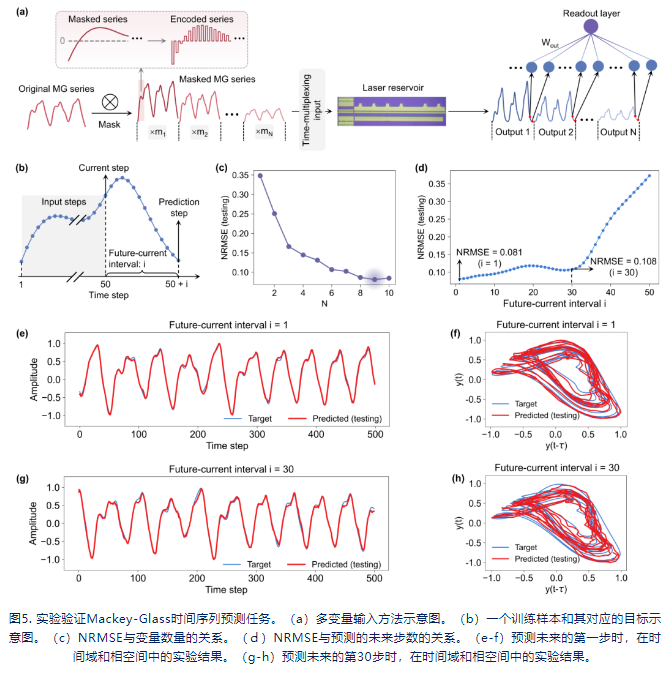
In summary, this paper presents a biomimetic photonic cascade neuron based on integrated quantum dot lasers and uses it as a laser reservoir layer, achieving high-speed reservoir computing with an information processing speed of 10Gbaud. Unlike typical physical reservoir systems that require feedback loops, we constructed a reservoir computing system that does not require time-delay feedback loops by utilizing the nonlinear dynamic characteristics and memory effects of laser cascade neurons. This design not only simplifies the system architecture but also avoids the limitations on signal processing speed caused by time-delay feedback loops. The reservoir computing system has shown good performance in tasks such as arrhythmia detection, MNIST handwritten digit image classification, and Mackey-Glass time series prediction. In the future, by utilizing faster lasers, the system's signal processing speed is expected to be improved to 100Gbaud. Additionally, we can cascade multiple laser cascade neurons together to form a deep reservoir structure to further enhance the system's performance.
Previous
Previous
LATEST NEWS
2025-01-09
Design and Development of Full-Spectrum Photodetectors
In recent years, the booming optoelectronic industry has changed the world and extended into many aspects of life. Among them, photodetectors (PDs) with a wide response bandwidth from deep ultraviolet to visible to near-infrared serve as important optoelectronic components and play a key role in daily life.
2025-01-08
Black arsenene multi-spectral integrated field-effect transistors, aiding high-resolution imaging and enhanced secure communication.
With the development of modern communication technology, the demand for broadband, room-temperature infrared, and terahertz (THz) detectors has rapidly increased. These detectors play a crucial role in fields such as telecommunications, security inspection, non-destructive testing, and medical diagnostics. However, existing optical detectors face challenges such as high intrinsic dark current and the need for low-temperature cooling, which limit their efficiency in detecting low-energy photons. Particularly in the terahertz band, the photon energy is insufficient to excite electron transitions from the valence band maximum (VBM) to the conduction band minimum (CBM), making effective optoelectronic conversion difficult. Therefore, researchers have been seeking ultra-broadband detectors that can operate at room temperature and respond to wavelengths ranging from visible light to the terahertz band.
2024-12-30
Laser-based tiered neurons achieve high-speed reservoir computing.
Neuromorphic computing is a computational paradigm that simulates the functions and architecture of biological neurons. A single biological neuron is a powerful computational unit with information processing capabilities, information transmission abilities, and memory functions. Therefore, it is crucial to design a photonic neuromorphic processor that can truly emulate the powerful computational functions of biological neurons.
2025-01-01
Design and Development of Full-Spectrum Photodetectors
In recent years, the rapidly growing optoelectronic industry has changed the world and extended into many aspects of life. Among them, photodetectors (PDs) with a wide spectral response from deep ultraviolet to visible to near-infrared serve as important optoelectronic components and play a key role in daily life.
2024-12-31
High-sensitivity quantum dot photodetectors from deep ultraviolet to near-infrared
In recent years, the rapidly growing optoelectronic industry has changed the world and extended into many aspects of life. Among them, photodetectors (PD) with deep ultraviolet-visible-near infrared full spectrum detection response serve as important optoelectronic components, playing a key role in daily life.

